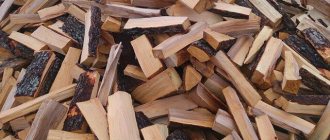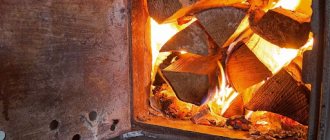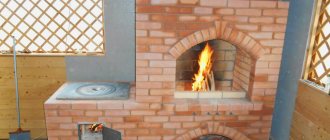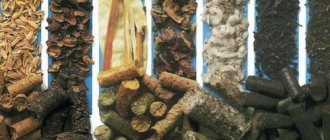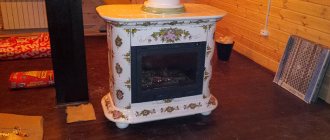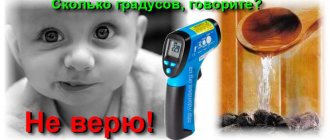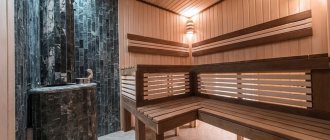Not long ago, an alternative fuel for lighting stoves appeared - fuel briquettes, which are positioned as an analogue of conventional firewood, but with better calorific characteristics. In order not to be unfounded, we decided to compare the capabilities of wood and European firewood, evaluate their technical characteristics, nuances of use and determine whether fuel briquettes or firewood are better for the consumer, which is more profitable.
Comparing firewood and fuel briquettes
Fuel briquettes or firewood – which is better?
It is advisable to start comparing different types of fuel with the cost of materials. If we analyze their price indicators, 1 m3 of Euro firewood will cost approximately twice as much as the same amount of ordinary logs. Moreover, the former are made from raw materials of varying value; the price of firewood is determined by the type of wood.
There are different products on the market. First-class briquette products have a denser structure, do not contain cracks or chips, and most often they are fired on the outside. Low-quality products are multi-layered, have lower density, and are vulnerable to mechanical damage. Such fuel burns faster and produces less heat.
The cost of fuel briquettes is approximately twice as much as regular firewood Source pankornik.pl
Advantages and disadvantages of artificial fuel
Eurofirewood got its name because of its regular geometric shape and is an alternative type of solid fuel (wood or coal). They are convenient for heating stoves, fireplaces, and using for solid fuel boilers and other types of heating appliances. In order to decide which type of fuel to give preference to, you should consider all the advantages and disadvantages of briquettes over firewood. To produce briquettes, waste from the food and wood processing industries is used. They include:
- sawdust;
- husks of cereals (rice, buckwheat) and industrial crops (sunflower);
- peat;
- straw.
The compressed briquette holds its shape due to the physical properties of the components included in its composition.
Ideal drying of the fuel material determines good combustion, compact and aesthetic appearance. No glue is used in the production of briquettes, so such products are environmentally friendly and safe for humans.
What to choose: coal or firewood?
Coal is perfect for heating boilers located in a separate room. It is not at all recommended to use it in a stove located in the home. This is due to the fact that such fuel burns for a long period and does not burn completely. For this reason, it is unacceptable to leave the chimney closed so that carbon monoxide does not accumulate in the room. At the same time, ordinary firewood always burns completely, releasing enough heat. This means that you can safely close the valve without fear for your health or heat leakage through the chimney.
Lighting charcoal without the right wood is a difficult task. Therefore, all those who use it are forced to purchase material for ignition.
Coal dust is considered quite harmful to human health. When throwing such fuel into the stove, you must try to prevent dust from rising into the air. Firewood contains almost no dirt, making it much safer.
As opposed to coal heating, traditional wood heating is more environmentally friendly: when burned, dry wood emits a small amount of carbon dioxide and therefore does not damage the natural environment. The latter is not typical for coal.
Unlike firewood, coal is not recommended for heating stoves located in residential premises Source tektarif.ru
What fuel should I use in my stove?
An important factor for maintaining a constant temperature is the correct choice of long-burning stoves, which are refueled periodically and the fuel in them burns much longer. Owners of country houses or summer cottages can use artificial firewood to heat their premises, but it is convenient to use briquettes to light a fireplace. To do this, it is better to place them on paper and birch bark, which will speed up the ignition process. In the same way, you can use firewood, which does not always light well. To prevent soot from remaining as sediment in the chimney, it is recommended to throw a pinch of table salt into the fire with each addition.
How to make briquettes with your own hands
If firewood or briquettes are not available, you can try to make the latter yourself. The main principle of Euro-firewood production is the compression of crushed wood waste until lignin begins to be released. This substance subsequently glues small particles into a monolithic product. For the production of fuel briquettes it is allowed to use: agricultural residues, sawdust, shavings, and other woodworking waste.
Procedure:
- Grind raw material.
- Dry to 10% moisture content.
- Using a hydraulic press or auger device, briquet the prepared raw materials.
Preparation of raw materials
As mentioned above, before the direct production of briquettes, the raw materials are crushed and dried. This process is not easy and takes place in several stages. To break down the largest waste, a 5P-RM type chipper is required. But the AC-3 aerodynamic dryer-shredder will help you finally prepare the waste for use.
You can use other similar devices, but these are the ones that in most cases provide the ideal result. Subsequently, the heat generator is switched on - and, finally, the worker gets the opportunity to form finished products.
Back to contents
Main varieties
There are three main types of Euro firewood offered on the modern market, which, while not having any fundamental differences in composition, differ from each other in the density of the internal structure and geometric shape:
- fuel briquettes RUF (RUF);
- European firewood Pini Kay (Pini Kay);
- fuel briquettes Nestro (Nestro).
Fuel briquettes Ruf
RUF wood briquettes, for the production of which sawdust, small chips or shavings are used, have the shape of a rectangle. They are distinguished by the lowest price when compared with other types of pellets. When using such fuel briquettes, it should be borne in mind that the heating boiler must be equipped with a forced ventilation system.
Fuel briquettes "Pini Kay"
Pini Kay fuel briquettes are fired at the final stage of production, which makes them more resistant to high humidity. Pellets of this type differ from RUF fuel briquettes in their geometric shape: in cross section they can have the shape of a cylinder or hexagon with a hole in the central part. Thanks to this hole, they can be successfully used even in ovens that are not equipped with a forced ventilation system. The cost of pellets of this type, which can be easily distinguished from RUF fuel briquettes even from a photo, is higher, which is explained by the more complex technology of their production.
Round fuel briquettes Nestro
Kinds
The method of processing raw materials plays an important role. Taking into account the manufacturing process, briquettes can be divided:
- Piny-kay. Fuel having the highest density of 1.40 g/cm3. The shape is similar to a cube or hexagon, which has a hole in the middle. The air inside the cavity ensures even combustion.
- Low density products – 0.8 g/cm3. These are squares or rectangles made from the smallest particles of material. They are characterized by high thermal conductivity and long-lasting combustion. Convenient to store and transport, do not take up much space.
- Products made from large sawdust with medium density. Their disadvantages include rapid combustion, frequent loss of shape and deformation. Due to low production costs, they have a relatively low price.
Pellets for solid fuel boilers
By analogy with briquettes, pellets are compressed granules from various woodworking and economic waste. The fuel is also environmentally friendly, has a homogeneous structure, but the calorific value is equal to that of coal. Pellets serve as fuel for pellet boilers, which are widely used throughout Europe.
Pellets for solid fuel boilers
The characteristics of pellets are similar to those of briquettes, however, they have such an indicator as humidity, which is no more than 10%. For comparison, freshly cut firewood has this figure within 50%. To maintain low humidity of pellets, they must be stored exclusively in a dry place, otherwise, as humidity increases, the calorific value of the pellets decreases. By the way, about storage: 1 ton of pellets occupies a space equal to 1 m (width), 1.1 m (length) and 1.6 m (height). It is preferable to store pellets in plastic bags.
As an example, we can give the characteristics of pellets made from sunflower husks:
You can buy pellets in Moscow for 5,500 rubles/t. both in big bags and in 25 kg bags. To find out in detail the cost of a product, you need to use price lists for pellets, where, in addition to the cost, the terms of delivery to consumers are indicated.
Initial data for calculation
Calculation of solid fuel consumption per boiler during the season depends on many parameters: the area of the house and the height of the ceilings, the average temperature in the cold season, the duration of winter, the quality of the thermal insulation of the walls, the heat transfer of the fuel and the efficiency of the equipment.
It will not be possible to take into account all the variables, but we can calculate the average value for different types of fuel so that you can compare and choose the option that is right for you.
- Let's take the duration of the cold season as 111 days, from November 27 to March 13.
- The area of the room is 100 square meters.
- The amount of heat to heat 1 square meter is 100 W per hour.
- Accordingly, there are 24 hours in a day and an average of 30 days in a month.
If necessary, you can substitute into the formula the actual area of the house, the duration of the cold season, depending on the region of residence.
Advantages of firewood compared to briquettes
- A major advantage of briquettes compared to firewood is their ability to generate stable heat over a longer period of time. Although the heat intensity is less than when using firewood. Therefore, if you want to quickly warm up the room with European wood firewood, as with ordinary wood, then you will not succeed.
- People who are used to spending the evening with a book or a cup of strong tea by the fireplace will most likely be disappointed. This fuel will not be able to please them with the crackling characteristic of ordinary firewood, which creates that unique feeling of home warmth and comfort. With the help of classic firewood, it is very easy to obtain the necessary “sound accompaniment”, since they contain water, but briquettes do not have it.
- When using Euro firewood, you will have to put up with the unpleasant smell of ash. Ordinary firewood will not give you such an unpleasant surprise, since wood ash does not emit a tart odor.
- Fuel briquettes, which are offered in stores today, are a rather fragile product that easily turn into crumbs. If you do not want to lose precious fuel before your eyes, then you should choose strong, high-quality briquettes.
Now it has become a little clearer about the advantages that firewood and fuel briquettes have. It remains to get an answer to one more question that worries many owners - which fuel is the most economical?

